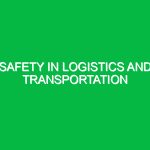Securing cargo for transportation is an essential component of logistics and supply chain management that directly impacts health, safety, and environmental (HSE) considerations. The process involves ensuring that goods are properly fastened and stabilized to prevent movement during transit. This is paramount not only for the safety of the cargo but also for the well-being of personnel involved in loading, unloading, and driving the vehicles transporting these goods. In this article, we will delve into the multifaceted aspects of securing cargo, including potential hazards, best practices, and regulatory frameworks that govern this critical activity.
The Importance of Securing Cargo for Transportation
Imagine a scenario where a truck carrying heavy machinery makes a sudden stop. If the cargo is not secured properly, those massive pieces of equipment could shift dramatically, posing a risk to the driver, other road users, and the integrity of the machinery itself. This example underscores the necessity of securing cargo effectively. Beyond road safety, proper cargo securing plays a vital role in reducing damage to goods, minimizing environmental impact, and adhering to legal requirements. The HSE perspective emphasizes that effective cargo securing safeguards not only the transported items but also protects workers and the public.
Identifying Hazards and Risks Associated with Securing Cargo
Securing cargo for transportation is fraught with potential hazards that can lead to accidents, injuries, and damage. Understanding these risks is the first step toward mitigating them.
1. Load Shifting
One of the most significant hazards in cargo transportation is load shifting. If the load is unstable or improperly secured, it can move during transport. This shifting can lead to loss of control of the vehicle, resulting in accidents. In one notable case, a freight truck experienced a catastrophic rollover due to improperly secured cargo, highlighting the importance of proper securing techniques.
2. Overloading
Overloading a vehicle can significantly increase the risk of accidents. Exceeding the vehicle’s weight limit can compromise its handling and braking capabilities. Furthermore, overloading can lead to legal repercussions, as transport regulations often stipulate specific weight limits for safety reasons.
3. Environmental Hazards
Cargo transporting hazardous materials poses specific dangers. If these materials are not secured correctly, leaks or spills can occur, resulting in environmental contamination. For instance, a chemical spill during transport can endanger not only the drivers but also nearby communities and ecosystems.
4. Worker Safety Risks
The process of securing cargo involves manual handling, which can lead to workplace injuries. Strains, sprains, and other musculoskeletal injuries are common if workers do not follow proper lifting techniques or if they are exposed to hazardous materials.
Safety Precautions and Best Practices for Securing Cargo
To mitigate the risks associated with securing cargo for transportation, several best practices can be implemented. These practices not only enhance safety but also ensure compliance with industry standards.
1. Assess the Load
Before securing cargo, it is crucial to assess its size, weight, and shape. This evaluation helps in determining the appropriate securing methods and equipment. For example, bulky items might require strapping, while smaller packages may be stacked and secured with shrink wrap.
2. Use Appropriate Securing Equipment
Using the right tools is vital. Tie-down straps, chains, and ropes are common methods of securing cargo. Each type of securing device has its specific application, and understanding how to use them is critical. For instance, ratchet straps provide a strong hold for heavier items, whereas bungee cords might suffice for lighter loads. Tools should be inspected regularly for wear and tear to ensure reliability.
3. Distribute Weight Evenly
Proper weight distribution is key to vehicle stability. Cargo should be loaded in a manner that allows even weight distribution across the vehicle. This practice minimizes the risk of tipping and enhances the overall safety of transport. For instance, placing heavier items on the bottom and towards the center of the vehicle can prevent shifting during transit.
4. Document and Train
Documentation of cargo securing procedures and training for all personnel involved in the loading process are essential. Regular training sessions can help workers understand the importance of securing cargo effectively, recognize hazards, and respond to emergencies. For example, companies can conduct drills simulating load-shifting scenarios to prepare their teams for real-life situations.
Regulations and Standards Governing Securing Cargo for Transportation
Compliance with regulations is not just a legal requirement; it is a crucial aspect of ensuring safety in the transportation industry. Various organizations and regulatory bodies set standards that govern cargo securing practices.
1. Federal Motor Carrier Safety Administration (FMCSA)
In the United States, the FMCSA outlines regulations for commercial vehicle operators, including guidelines on securing cargo. The FMCSA mandates that cargo must be secured in a manner that prevents it from shifting or falling during transit. Their regulations provide specific guidance on the use of tie-downs, blocking, and bracing.
2. Occupational Safety and Health Administration (OSHA)
OSHA also plays a vital role in establishing safety standards for workers involved in cargo securing. Guidelines emphasize the importance of safe lifting techniques and the proper use of personal protective equipment (PPE) during the securing process.
3. International Standards Organization (ISO)
Globally, the ISO has developed standards that address the safe transport of goods. ISO 3874 sets out criteria for the securing of cargo, covering a range of transport methods including road, rail, and maritime. Compliance with these standards is essential for international shipping and logistics.
Conclusion
Securing cargo for transportation is a multifaceted topic that intertwines health, safety, and environmental considerations. By understanding the potential hazards associated with cargo securing and implementing best practices, organizations can create a safer work environment and reduce the risk of accidents. Staying compliant with relevant regulations not only safeguards workers and the public but also enhances the reputation of the organization within the industry. Ultimately, effective cargo securing is not just about logistics; it is about ensuring the safety and sustainability of our transportation systems.


